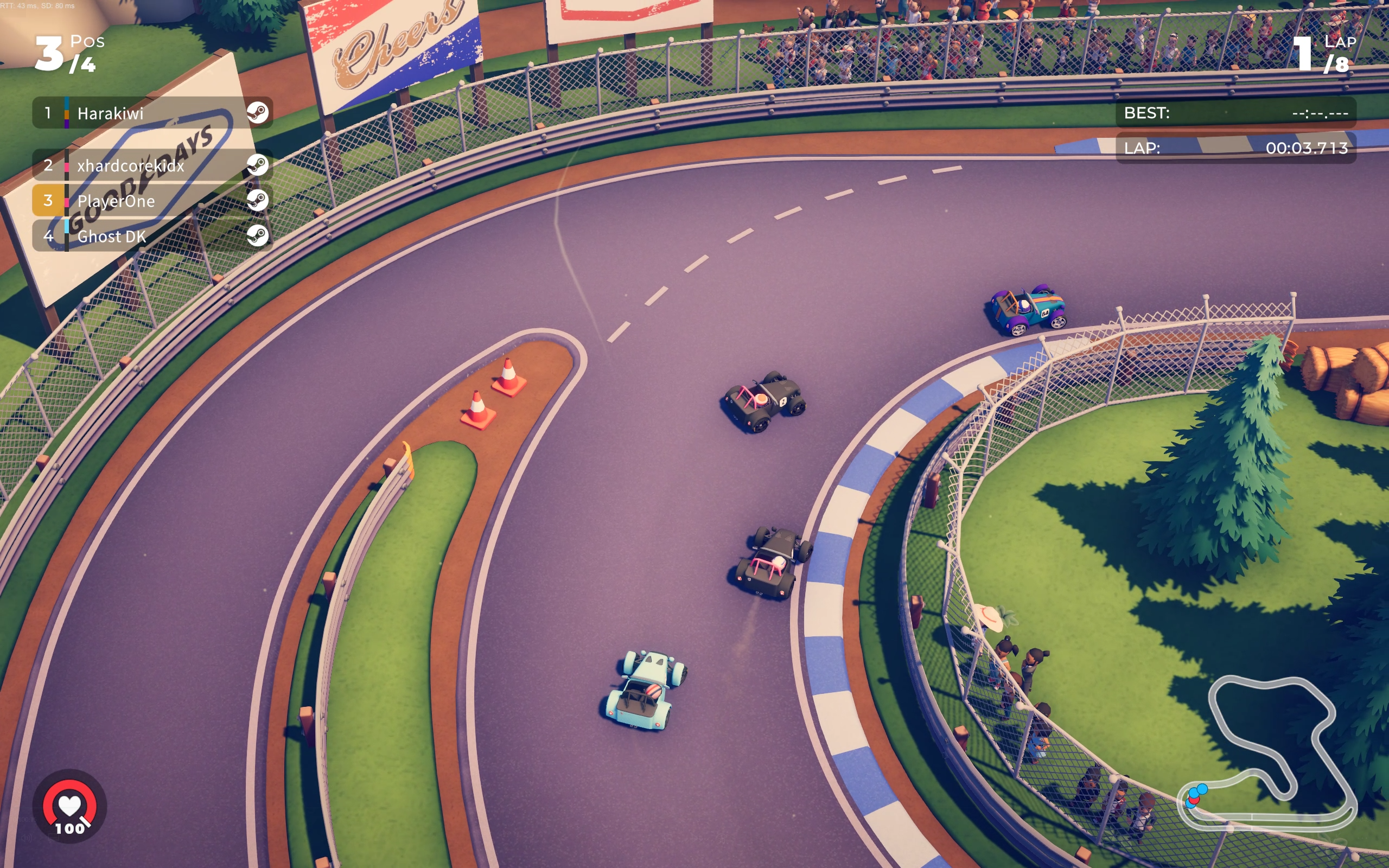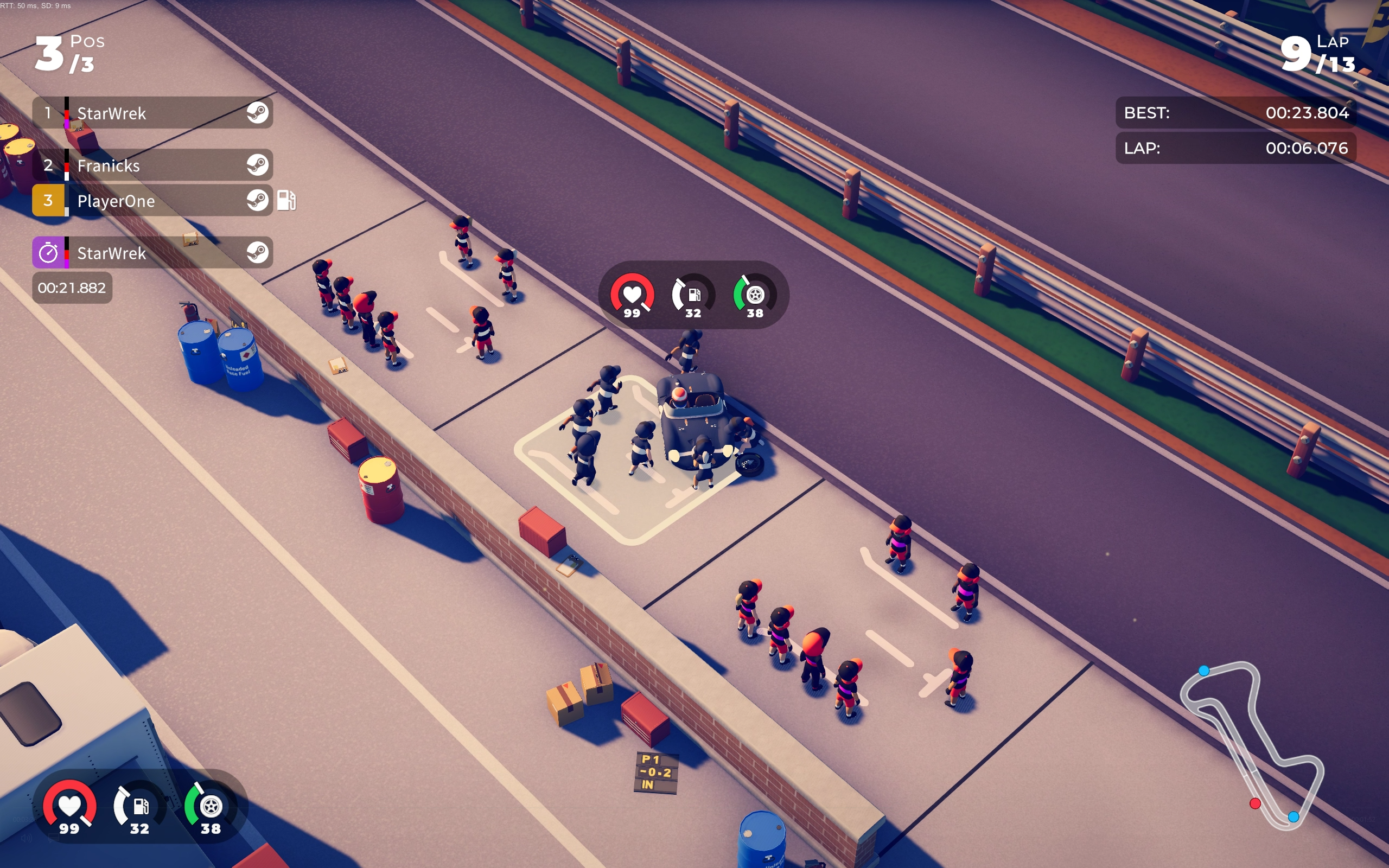Our Verdict
Please make more games, Original Fire. Show the rest of the genre how 'sim-meets-arcade' is done.
PC Gamer's got your back
What is it? An isometric racer with genuine sim chops.
Expect to pay $20/£15
Release October 12
Developer Original Fire Games
Publisher Square Enix Collective
Reviewed on i7 9700K, RTX 1080 TI, 16GB RAM
Multiplayer? Up to 12 players
Link Official site
In the time it takes to read this sentence, 17.3 game developers will try and fail to do what Circuit Superstars does: a mix of arcade and sim racing that feels enriched, not compromised, by both. Admittedly that was quite a long sentence. Still, the point stands.
Every racing game press release since 1997 has promised a perfect blend of arcade accessibility and a depth of simulation that rewards continued effort with gradual mastery, and we’re right to react like dogs hearing a high-pitched noise when we see it because nobody actually pulls it off. Not really. Nobody but Vancouver-based Original Fire Games, releasing its debut under the Square Enix Collective indie initiative.
If you’re a veteran of many a cross-legged Micro Machines campaign from the 16-bit days or, to be honest, if you’ve simply seen a screenshot and clocked the isometric camera, you’ve got a handle on how it feels to drive. What isn’t evident until your first race is the sheer amount of subtlety baked into those adorable little vehicles. Going fast here is about picking out and committing to perfect racing lines, keeping all inputs smooth, and holding onto momentum like it’s a fistful of James May’s M&S Autograph blazer after he wanders a bit too close during a Grand Tour filming.

Each day I’ve gone back to it, I’ve found some new way to unlock more speed. A micro-revelation that makes me want to go through every racing series—twelve, since you ask—all over again. It is, I’m surprised to find, my favourite racing game for years.
Tracks rubber up as the laps go by, revealing thick, tar-like stripes of freshly laid tire where extra grip and lap time can be found. Conversely, in events with tire deg enabled, you’ll lose pace alarmingly quickly unless you focus your driving style on modulated throttling and minimal steering under throttle or braking. Another part of your brain still is keeping an eye on fuel, wondering if you can lift and coast to the end or whether a pit stop’s going to be required instead. In a game that looks like this, remember.
It is, I’m surprised to find, my favourite racing game for years
Original Fire finds a style of track design that works really well with both its camera perspective and vehicle physics, and in its twelve circuits—with 18 total layout variations—lies a long-term challenge. Mastering the lines well enough to perform respectably online, and fine-tuning that muscle memory in search of time trial leaderboard perfection.
This being an indie, and an indie debut at that, you can forgive its light online proposition. Still, it’s a shame that even with an online lobby feature that lets you buddy up as a party of four, you still have to race in public lobbies with up to eight strangers, and can’t create event types from scratch. The community’s certainly voiced an appetite for some extra control over lobby creation since the game first went live on Early Access in March, but we’re still forced to face the stranger danger when the servers find people waiting to race our party.

Worse, I found some races laggy to the point of being uncompetitive. The slowest connection on the server seems to drag everyone’s ping down, which can be all kinds of heartbreaking if you got away in front out of turn one only to realise you haven’t actually taken turn one yet.
That’s not to say those strangers themselves are a bad lot, you understand. Partly motivated by the unforgiving collision physics and perhaps partly by the air of joviality inherent to a game about tiny vehicles racing through Aardman Animation sets, they’re usually sporting—and about three seconds a lap quicker than you. That Early Access did come out in March, after all.
The game itself is pretty laissez-faire about racing conduct. Brief time penalties are incurred when you cut corners, and you can see exactly how much cutting constitutes a penalty by observing the marker poles beyond the apexes. No penalties are handed out for contact, other than the time both parties lose for playing silly buggers and inevitably heading off track. It might not always feel fair, but which online racer does? It is, at least, clear and consistent in its race marshalling.
Offline, the racing takes on a different complexion. AI drivers always come out of a tangle better off than you and your apparently feather-light car, so the onus is very much on you to find clean overtaking opportunities and perform in the quali hotlap sessions that precede most races.

Oddly enough, there’s no mid-series save function in offline races, so later series that feature five 10+ lap races must be taken on in one session. The community’s been asking for this feature for a while too, but their collective prayers have yet to be answered. It’s not like asking someone to drive a season of F1 2021 in one sitting, but it’s an inconvenience all the same.
A real and formidable talent has emerged in Original Fire Games
Without the usual career mode we’re used to from modern racers, the longform proposition here is beating increasingly ruthless AI in each series, mastering twelve distinct handling models in the process. With the naivety of a newborn babe, I selected the superstar AI difficulty for my debut in the Piccino Cup. I was lapped inside the first three minutes of my career. And it’s lucky for them they have such natural pace, because their racecraft leaves much to be desired.
They’re capable of making mistakes independent of your driving, creating pileups you can either exploit or get collected by. This is a good thing. But given their tank-like physical properties, those AI mistakes can also cost you vast, desperate handfuls of time and put paid to your victory bid in a single clang. Solo races are best viewed as a training aid for clean online conduct, then.
If you ask me, and you have, a real and formidable talent has emerged in Original Fire Games. Somehow, using some cute little cars, a camera perspective from the arcades of yesteryear and surprising sim touches, it makes all-out racing sims feel a bit like doing a tax return by comparison.
Please make more games, Original Fire. Show the rest of the genre how 'sim-meets-arcade' is done.
Phil 'the face' Iwaniuk used to work in magazines. Now he wanders the earth, stopping passers-by to tell them about PC games he remembers from 1998 until their polite smiles turn cold. He also makes ads. Veteran hardware smasher and game botherer of PC Format, Official PlayStation Magazine, PCGamesN, Guardian, Eurogamer, IGN, VG247, and What Gramophone? He won an award once, but he doesn't like to go on about it.
You can get rid of 'the face' bit if you like.
No -Ed.



